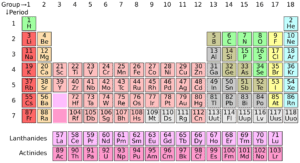Remember, this is a general knowledge website. If you regularly hang out at a particle accelerator, you’re going to want to look elsewhere. On the other hand, if you’re just sort of regular, this ultra-brief and somewhat incomplete answer should suffice. What is nuclear fusion in simple terms? Read on.
The Ridiculous Basics
Look around you. Everything you see—including yourself—is made of atoms. To identify a type of atom, you have to zoom in on the nucleus and spot the number of protons, also known as the atomic number.
A hydrogen atom has one proton, a helium atom two, a lithium atom three, etc. Here’s a miniature periodic table if you’re so inclined.

Doing some simple math, you might realize that if you fuse the nucleus of one hydrogen atom with the nucleus of another hydrogen atom, you would have two protons, also known as a helium atom.
And that, in a nutshell, is nuclear fusion.
More Basics
Nuclear fusion is not a mere hypothetical concept. Something extremely familiar to us uses it to power itself. That something, as you could have guessed, is the sun.
It turns out that stars like the sun are massive nuclear fusion factories, regularly turning hydrogen into helium, helium into carbon, and so on.
Not mentioned above is that nuclear fusion typically results in the release of energy, which can then be used to power more nuclear fusion, and so on. In other words, the sun is sustained by the process, all the while releasing the energy that is a key ingredient to the experiment we call life.
Needless to say, as the sun’s hydrogen reserves run low, we’ll have a serious problem on our hands. Thankfully, that’s billions of years off, meaning we can continue to complain that the barista put too much milk in our macchiato for a while.
Why Are We Talking About This?
Humans have long realized that if we can recreate what goes on in the sun (at a much smaller scale), we can solve our earthly energy issues.
The idea of playing with nuclei is in fact in full practice as we speak. Of course, that pertains to breaking apart nuclei to release energy, also known as nuclear fission, most commonly done with uranium.
While nuclear fission could be a key part of a carbon-neutral future, a few high-profile disasters have earned it a bad rap. And short of such disasters, the radioactive waste sticks around for a long time, requiring safe storage.
Nuclear fusion, in contrast, would generate waste that is less radioactive and decays more quickly. Furthermore, it could run predominantly on various forms of hydrogen that are not particularly difficult to come by. Finally, as with fission, it would not generate greenhouse gases.
The fact that we’re not using what seems like a win all around tells you one thing—it’s a lot easier said than done. Inside the sun is a massive amount of heat and pressure that facilitates nuclear fusion. Stated another way, you have to spend gobs of energy to get gobs of energy.
On December 5, 2022, scientists working at a huge government-funded laser complex in California—the main purpose of which is to study nuclear weapons—were able to zap a pellet of hydrogen using multiple laser beams and release more energy than what was required to make the process happen. The calculation only includes the energy delivered by the lasers and doesn’t take into account the energy required to actually run the lasers, but we can leave those details aside for now. The point is that the idea of mimicking what goes on in the sun might not be so far-fetched.
Naturally, figuring out how to scale the concept and incorporate it into power plants will be a true battle, one that, if winnable, could take several decades to conquer.
So what is nuclear fusion? Let’s just say it’s kind of like jazz fusion, where the two hydrogen atoms are like jazz and rock, and the result is some serious energy!
4 Responses
Kudos to the scientists for their hard work, hope they have music playing in the background!
Absolutely. Their mix of brilliance and hard work (and perhaps some good music) moves us all forward!
50 yrs down the line kids could be saying fossil fuel , what is that, never heard of it!
Hahaha. That’s the hope!